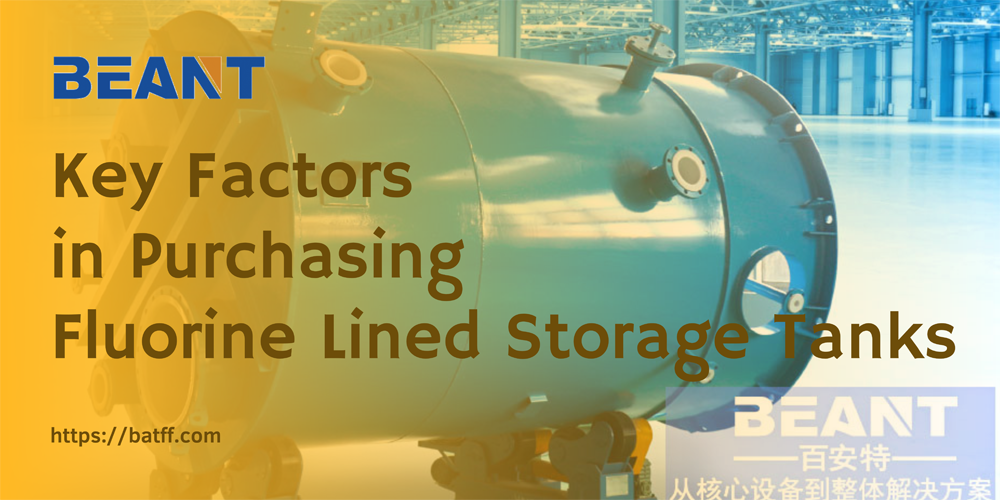
Fluorine lined storage tanks are integral to the petrochemical industry due to their superior resistance to corrosion and chemical reactions. These tanks are essential for storing aggressive chemicals safely, ensuring the longevity of the storage equipment and protecting the integrity of the stored substances. This article delves into the critical factors one must consider when purchasing fluorine lined storage tanks, providing a comprehensive guide to making informed decisions.
Fluorine lined storage tanks are designed to store highly corrosive chemicals and substances. They are typically made from robust materials such as steel or fiberglass and lined with a fluoropolymer to enhance chemical resistance.
Chemical Resistance: Fluorine linings can withstand a wide range of aggressive chemicals, including acids, bases, and solvents.
Durability: These tanks offer a long service life due to their enhanced resistance to corrosion and chemical degradation.
Versatility: Suitable for various industries, including petrochemical, pharmaceutical, and wastewater treatment.
| Component | Description |
| Base Material | Typically steel or fiberglass for structural strength |
| Lining Material | Fluoropolymers like PTFE (Teflon), PFA, or FEP for chemical resistance |
| Applications | Storage of corrosive chemicals, acids, solvents, and other aggressive substances |
The selection of materials and the construction process are pivotal in determining the performance and durability of fluorine lined storage tanks.
PTFE (Polytetrafluoroethylene): Known for its excellent chemical resistance and non-stick properties.
PFA (Perfluoroalkoxy Alkane): Offers similar chemical resistance to PTFE but with improved thermal stability.
FEP (Fluorinated Ethylene Propylene): Provides good chemical resistance and ease of processing.
Material Selection: Choosing high-quality base materials and lining materials to ensure maximum durability and chemical resistance.
Fabrication: Involves precision techniques to apply the fluorine lining uniformly and securely.
Quality Control: Rigorous testing to ensure the lining is defect-free and meets industry standards.
One of the primary reasons for choosing fluorine lined storage tanks is their exceptional resistance to corrosion.
Safety: Prevents leaks and spills of hazardous chemicals, ensuring a safe working environment.
Cost-Efficiency: Reduces maintenance costs and extends the lifespan of the tank, offering better long-term investment.
Product Integrity: Protects the purity of stored chemicals by preventing contamination from corroded tank materials.
Ensuring chemical compatibility is crucial when selecting a fluorine lined storage tank. The tank must be able to safely contain the specific chemicals it is intended to store without degrading or reacting.
Chemical Concentration: Higher concentrations of certain chemicals may require specific types of fluorine linings.
Temperature: Elevated temperatures can affect the performance of the fluorine lining, requiring careful selection based on operating conditions.
Chemical Mixtures: Compatibility with mixtures of chemicals should be verified to prevent unexpected reactions.
Hydrochloric Acid (HCl)
Sulfuric Acid (H2SO4)
Sodium Hydroxide (NaOH)
Organic Solvents (e.g., Toluene, Methanol)
The durability and longevity of fluorine lined storage tanks are critical for ensuring they provide a long-term, cost-effective solution for chemical storage.
Material Quality: High-quality base and lining materials are essential for maximum durability.
Manufacturing Process: Precision in the application of the lining and adherence to quality standards impact the tank's longevity.
Operational Conditions: Proper maintenance and adherence to operational guidelines extend the tank's service life.
Regular inspections for signs of wear or damage to the lining.
Routine cleaning to prevent build-up of residues that could affect the lining.
Monitoring of stored chemicals for any changes in properties that might affect the tank.
| Tank Type | Expected Lifespan |
| Fluorine Lined | 15-20 years |
| Rubber Lined | 5-10 years |
| Epoxy Coated | 3-7 years |
Safety and compliance are paramount when dealing with chemical storage to ensure the protection of personnel, property, and the environment.
OSHA (Occupational Safety and Health Administration): Sets guidelines for safe handling and storage of hazardous chemicals.
EPA (Environmental Protection Agency): Regulates the environmental impact of chemical storage, including spill prevention and control measures.
ASME (American Society of Mechanical Engineers): Provides standards for the design and construction of pressure vessels and storage tanks.
Ensuring that tanks meet or exceed industry standards is crucial for operational safety and legal compliance.
Regular audits and inspections can help maintain compliance and identify potential issues before they become critical.
Proper containment and handling procedures to prevent spills and leaks.
Implementation of secondary containment systems to capture any accidental releases.
Regular training for personnel on safe handling practices and emergency response procedures.
When investing in fluorine lined storage tanks, it's essential to evaluate both the initial costs and the potential long-term savings.
Initial Cost: Fluorine lined tanks typically have a higher upfront cost due to the quality of materials and the manufacturing process.
Long-Term Savings: The superior durability and chemical resistance of fluorine lined tanks reduce maintenance costs and extend the lifespan, resulting in significant savings over time.
Material Selection: Different types of fluorine linings (PTFE, PFA, FEP) have varying costs.
Tank Size and Specifications: Larger tanks and those with custom specifications will cost more.
Manufacturer's Reputation: Established manufacturers may charge a premium for their proven track record and quality assurance.
Choosing the right supplier is a critical step in ensuring the quality and reliability of fluorine lined storage tanks.
Experience and Expertise: Suppliers with a proven track record in manufacturing fluorine lined tanks are more likely to deliver high-quality products.
Reputation: Researching supplier reviews and industry reputation can provide insights into their reliability and customer satisfaction.
Quality Assurance: Suppliers should have robust quality control measures in place to ensure the tanks meet industry standards and specifications.
1.What materials do you use for the fluorine lining, and why?
2.Can you provide references from previous customers who have used your tanks for similar applications?
3.What is your process for quality control and testing?
4.Do you offer any warranties or guarantees on your tanks?
5.How do you handle repairs and maintenance for your tanks?
Purchasing fluorine lined storage tanks involves careful consideration of various factors to ensure the best investment for your chemical storage needs.
Feel free to leave your message on our board. If you're looking to inquire about prices or place an order, this is the right place! Let us know the details of your needs, and our team will get back to you with a personalized quote as quickly as possible. We're here to ensure your experience is seamless and satisfactory. Share your requirements or ask any questions you might have - we're eager to assist and look forward to doing business with you!
Name:Tim
Phone:+86-15716151880
Email:[email protected]
Company:BEANT
Address:No. 28, Luoshen Road, Luoshe Town, Huishan District, Wuxi City, Jiangsu Province
